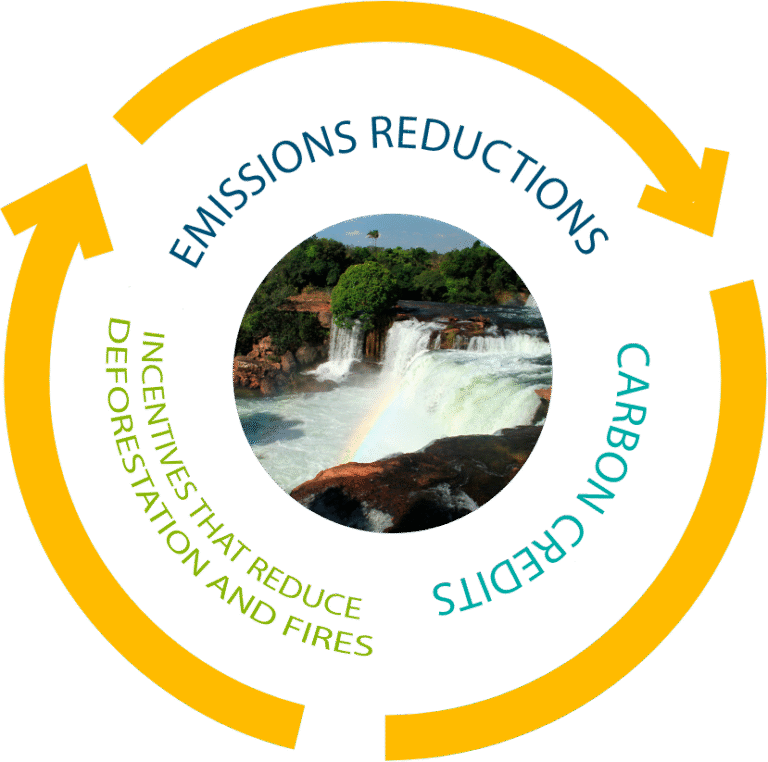REDD+ is an international financing instrument created under the United Nations Framework Convention on Climate Change (UNFCCC) to preserve native forests and encourage developing countries to reduce carbon emissions from the forestry and land use sectors through:





reducing
emissions
from deforestation
and forest degradation
conserving and increasing forest stocks, and sustainable forest management
Within the scope of the UNFCCC, the Warsaw Framework for REDD+ (2013) was created to establish the requirements for the recognition of mitigation results in the forestry sector and for obtaining payments for countries’ REDD+ results at the national level.
Through this mechanism, proven reductions in forestry carbon emissions are rewarded with “payments for results”. These payments are made for mitigation results, measured in equivalent tons of CO2, and channeled through various international sources, particularly the Green Climate Fund (GCF). Elements required by the Warsaw Framework for the recognition of REDD+ results are:

Set of policies and/or incentives for reducing carbon emissions from forests in the country. The results must be anchored in the implementation of actions which aim to reduce, halt, or reverse deforestation and degradation, conserve and increase forest carbon stocks, and encourage sustainable forest management.
Monitoring, Reporting and Verification (MRV) system to generate high-quality and reliable data on forests, including forest carbon estimates that allow monitoring of activities and results of REDD+ actions. In general, these systems use satellite images that identify deforestation and degradation in the territory; as well as forest inventories or other data sources which estimate the amount of carbon in forests.
The reference level is a parameter which evaluates the country’s performance in implementing REDD+ activities. Each country’s FREL has its own methodology that technically supports the quantification of reductions in carbon emissions from forests, establishing a baseline demonstrated in tons of equivalent CO2 per year, depending on which REDD+ results will be measured.
A system for collecting, managing and disseminating information on how socio-environmental safeguards are being addressed and respected by the design and implementation of REDD+ actions across the country.
Brazil has already fulfilled the four requirements of the Warsaw Framework, and periodically communicates its results to the UNFCCC in reducing its emissions from deforestation and forest degradation. Communication of Brazil’s results can be found at Information Hub Brazil. As compensation for the results already achieved, Brazil receives results-based payments from donors such as the Green Climate Fund and the government of Norway through the Amazon Fund.
The National Commission for REDD+ (CONAREDD+) is responsible for the coordination, tracking, monitoring, and reviewing Brazil’s National Strategy for REDD+ and coordinating the proof of requirements for access to payments for results under the UNFCCC.
In addition to the National Strategy, Brazilian states can also access results-based payments through the REDD+ mechanism and promote its regulation at state-level. In this context, the State of Tocantins structured its policies for REDD+ actions and became eligible to raise payment resources based on REDD+ results from the Amazon and Cerrado before CONAREDD+ (CONAREDD+ Resolution No.5 2021).
In addition to payments for results obtained at national level under the UNFCCC, there are other REDD+ approaches, such as results-based payments made to subnational entities. This is the case of the REDD+ Early Movers (REM) Program of the German bank KfW, in which the states of Acre and Mato Grosso participate. Whether in national or subnational form, results-based payments are known as a ‘non-market’ approach, as they do not result in the generation and commercialization of carbon credits.
By contrast, REDD+ in the ‘market’ approach can exist either at the jurisdictional scale (including the entire national or subnational territory led by the government) or individual private project scale (on a private property or collective territory). In these cases, carbon credits will be generated that can be traded on regulated and voluntary carbon markets.
REDD+ IN THE NON-MARKET APPROACH (PAYMENTS FOR RESULTS)
REDD+ IN THE MARKET APPROACH
*1 carbon credit = 1 ton of CO2 avoided

In the voluntary carbon market, whoever designs the jurisdictional project or program using the market approach must go through a rigorous process of validation and verification of emission reductions, which evaluates all aspects of how it was constructed and the results to ensure the environmental and social integrity of the initiative. After approval and registration, the certifying entity issues carbon credits, which can be sold to countries or other interested parties.
The jurisdictional program does not impede individual REDD+ projects.